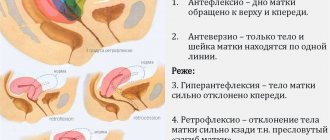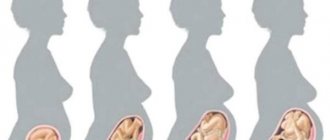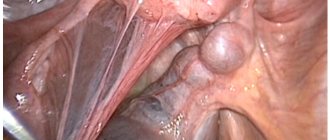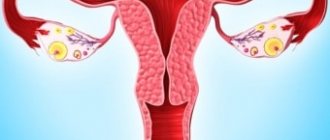Causes
The adhesive process is a formation of connective tissue that occurs as a result of an inflammatory process or surgical intervention. The tissues of the organs located in the pelvic area “stick together” with each other, thereby preventing the spread of inflammation to nearby areas. After completion of the inflammatory process, tissue fusion may occur in the places of “gluing” - the formation of adhesions .
The likelihood of developing an adhesive process is quite high in the following cases:
- in the presence of inflammatory diseases in the pelvic organs;
- after surgical operations (for example, removal of the appendix);
- with endometriosis;
- in case of blood entering the abdominal cavity.
Adhesions – protection against inflammation
By and large, the formation of adhesions is a protective reaction of the body. The uterus, appendages (ovaries, tubes), bladder, rectum are located inside a thin membrane - the peritoneum. It is smooth and inside there is a small space filled with fluid, which allows the organs to mix freely relative to each other. For example, a full bladder slightly pushes the uterus and rectum, a full intestine pushes aside the bladder or uterus, and the growing uterus after conception causes all other organs to “shrink.”
When inflammation occurs in the abdominal cavity, the membrane near this place swells and a sticky coating appears on it. This “glue” contains fibrin, the protein basis of blood clots. This sticky substance “seals” the inflamed area to prevent the inflammation from spreading. When the disease passes, the fibrin plaque dissolves quite quickly on its own. If the disease lasts a long time, more stable compounds (collagen, etc.) “sprout” in the adhesive layer. These bridges can no longer dissolve. Instead of the former temporary “gluing”, strong structures of connective tissue appear - adhesions.
The formation of bridges not provided for by normal anatomy interferes with the internal organs and deprives them of mobility. Connecting bridges in the intestines can cause intestinal obstruction. Adhesions in the uterus reduce the chance of getting pregnant. But the fallopian tube suffers the most. This is a very delicate and poorly protected organ. In its normal state, the tube makes wave-like movements, moving the sperm towards the egg. It is here that fertilization occurs, and the first few days of the embryo’s life take place here until it reaches the wall of the uterus and attaches to it. If adhesions have formed in the fallopian tube, the risk of ectopic pregnancy increases, and infertility is possible.
Important! Doctors classify the adhesive process as a separate category of diseases. But the connecting bridges themselves are a reaction to long-term, untreated inflammation.
Why do connecting “ropes” appear?
The body strives to “close” any damage through the formation of new cells. This is a rather lengthy process. If there is a need to eliminate a “hole” as quickly as possible, the body “patches” it with connective tissue. This is why major damage (surgery, serious injury) entails the formation of adhesive tissue. For example, as a result of a cesarean section, connective tissue appears twice as much as after laparoscopy.
Chronic inflammatory diseases, such as sexually transmitted diseases or intestinal problems, can have the same consequences. The appendages sometimes suffer from inflammation in neighboring organs. Immunity in the fallopian tubes is very low. This is physiologically justified so that the body does not consider the embryo a foreign body and reject it. Therefore, the tubes often “pick up” pathogens from the vagina or uterus. First, the inner surface of the pipes is affected, then the smooth muscles are affected. If the therapy was not carried out on time, the cilia of the tubal mucosa are smoothed out, the muscles are replaced by adhesions and the likelihood of pregnancy decreases sharply. Strong connections are formed between pipes and other organs. Even if it is possible to remove the bridges through surgery, the functions of the pipes will not be fully restored.
It is recommended to find out whether it is safe to treat teeth during pregnancy with Ultracaine.
Note: why does eclampsia occur in pregnant women?
What affects the appearance of adhesions:
- trauma and surgery;
- inflammation in the pelvic area (in the uterus or appendages), prolonged wearing of the IUD, sexually transmitted diseases;
- infection and inflammation of organs in the abdominal cavity;
- ectopic pregnancy;
- endometriosis (overgrowth of the intrauterine epithelium).
Endometriosis is characterized by the proliferation of cells of the internal epithelium of the uterus in uncharacteristic areas: on the peritoneum, in the ovaries or tubes. This is the result of living endometrial cells entering the peritoneum along with a small amount of blood during menstruation. In a healthy body, these cells are easily dealt with by the immune system. But if there are any deviations, the cells “take root”, “islands” of the inner uterine membrane appear, around which connective tissue grows. Treatment of the disease includes hormonal drugs. If adhesions are detected and removed in time, then in most cases a woman can become pregnant.
Symptoms
The following symptoms indicate the development of the adhesive process:
- the appearance of pain at the site of adhesions;
- intestinal obstruction, constipation or diarrhea;
- increased body temperature;
- nausea, vomiting.
The above symptoms usually appear in the acute form of the development of the adhesive process. In the case of a chronic course of the disease, periodic aching pain in the lower abdomen may occur and intestinal function may be disrupted. Sometimes the adhesive process is asymptomatic.
How do adhesions affect pregnancy?
Synechiae are connective tissue cords in which blood vessels and nerve endings can pass. They can be of different densities - from woody to mucus-like, of different sizes and connect tissues of the same organ or different ones. It all depends on the cause of their occurrence, the duration of the process and individual predisposition to adhesions.
In the uterine cavity
The reasons for the formation of adhesions may be different. Synechiae in the uterine cavity (synechia) can be of an inflammatory nature or be a consequence of traumatic damage to the endometrium. It is extremely rare that adhesions are congenital.
The likelihood of pregnancy is affected by the location of adhesions, their number, as well as concomitant changes in the endometrium. As a rule, there is thinning and a decrease in vascularization (filling with blood vessels), which leads to impaired implantation of the fertilized egg. Adhesions in the uterine cavity rarely do not affect pregnancy. They may not appear clinically for a long time, and when planning pregnancy, they become a cause of infertility, since:
- close the cervical canal from the inside - the location of synechiae in the cervical canal or above the internal os creates a mechanical obstacle for sperm on the path of their advancement; such localization of synechiae can even significantly complicate the procedure for intrauterine embryo transfer into the uterine cavity during IVF;
- interfere with implantation - numerous synechiae in the body of the uterus interfere with the attachment of the fertilized egg to the endometrium, therefore, even in the case of successful fertilization, the pregnancy is terminated at a short period;
- disrupt the passage of blastocysts from the fallopian tubes - when synechiae are located in the area of the mouths of the fallopian tubes, the fertilized fertilized egg cannot penetrate the uterine cavity, which can ultimately lead to an ectopic pregnancy.
Adhesions around the uterus involving the fallopian tubes. Adhesions (synechia) inside the uterine cavity.
In the pelvis - around the ovaries, fallopian tubes, intestines
In this case, adhesions are a consequence of previous inflammatory processes or surgical interventions. They are formed outside the internal genital organs - the uterus, fallopian tubes, and attract loops of the small and large intestines, the bladder, folds of the peritoneum, and ligaments to them.
One of the most common causes of infertility is tubal factor. In this case, a mechanical obstacle is created on the path of the sperm to the egg - adhesions. They can occur both outside the fallopian tubes and inside.
The most dangerous in this case are the adhesions that surround the fallopian tubes. They tighten their clearance, impairing patency. Also, connective tissue cords can “seal” the fimbrial section of the fallopian tubes, leaving other areas intact. In this case, a mature egg, leaving the ovary, cannot enter the fallopian tube, which leads to infertility.
In this case, there is a high probability of the formation of hydrosalpings - an accumulation of fluid in the fallopian tubes.
Severe adhesions between intestinal loops, ovaries and fallopian tubes can lead to the formation of a single conglomerate of organs, which also disrupts their function and causes severe pain and impossibility of pregnancy.
Adhesions between intestinal loops can cause an abnormal location of the ovaries - away from the fimbrial part of the fallopian tubes, as a result, even normal ovulation does not lead to pregnancy, since the sperm cannot penetrate here.
Thus, adhesions in the pelvis increase the risks of the following complications and diseases:
- infertility;
- ectopic pregnancy;
- hydrosalpings;
- chronic pelvic pain.
And here is more information about planning a pregnancy with one fallopian tube.
Diagnostics
To reliably determine the presence of adhesions in the pelvic organs, the following methods are used:
- Ultrasound examination (ultrasound) of the abdominal organs;
- magnetic resonance imaging (MRI);
- diagnostic laparoscopy is an operative, low-traumatic method in which it is possible not only to diagnose, but also to eliminate existing adhesions;
- taking a smear from the vagina to identify the causative agent of a possible infection.
important Of course, during pregnancy it is better to avoid laparoscopic examination and tomography due to the high risk of complications for the developing fetus. In this case, the doctor may recommend that the woman undergo an ultrasound.
Why is the diagnosis dangerous?
There are indeed reasons to worry. Adhesions can lead to serious complications:
- adhesions located in the tubes significantly increase the risk of ectopic pregnancy;
- adhesions on the ovaries can not only disrupt the menstrual cycle, but also lead to frequent inflammation of the ovaries;
- the adhesive process leads to infertility.
And this is not to mention the fact that adhesions are fraught with stagnation of blood, disruption of lymph flow, painful spasms, etc.
Treatment
The process of treating adhesive disease consists of performing the following activities:
- taking medications to fight a bacterial infection (for example, chlamydia) in order to eliminate the source of the inflammatory process;
- hormonal treatment (for endometriosis);
- prescribing drugs that help dissolve fibrin (a protein that is a component of adhesions);
- physiotherapy procedures: electrophoresis, therapeutic massage;
- surgical dissection of adhesions (mainly using laparoscopy).
During pregnancy, the selection of a treatment method for adhesive disease should be carried out exclusively by a doctor, taking into account the woman’s condition and possible contraindications.
Treatment and prevention
Like other gynecological diseases, adhesions are subject to two treatment options - conservative and surgical .
The conservative method serves both to prevent the formation of adhesions and as a method of treating a process that is not so advanced. A woman is prescribed a number of medications, including:
- anti-inflammatory drugs;
- agents that prevent fibrin formation (after surgery);
- drugs that prevent blood clotting;
- vitamin injections.
A course of physiotherapy is almost always prescribed. It is very important for a woman to lead a fairly active lifestyle and engage in physical exercise: it is much less likely that organs will grow together if a woman moves a lot.
Surgical treatment usually involves laparoscopic surgery. The patient is given 3 punctures in the anterior abdominal wall, a mini-video camera with light is inserted, and the other punctures serve as micromanipulators in the operation itself.
An alternative to surgery is gynecological massage . This procedure is really effective, but the treatment will require about 10 sessions, lasting about half an hour.
The procedure requires preliminary anesthesia. There are diagnoses that are incompatible with gynecological massage, and the doctor does not always agree to such a long, labor-intensive procedure. However, its benefits are really great.
The course of pregnancy during adhesions
Very often, a woman learns about the presence of adhesions only with the onset of pregnancy. On the one hand, this is a good sign: it means that the activity of vital organs is not impaired due to the development of the adhesive process. But, on the other hand, for the treatment of adhesions during this period, the choice of methods is quite limited .
To reduce the intensity of pain, the expectant mother is recommended to eat small meals at least five times a day so as not to overload the intestines. It is also necessary to avoid foods that cause increased gas formation in the lower parts of the digestive tract.
dangerous If the adhesions are partially attached to the uterus, then as this organ enlarges, the woman may experience severe pain in the lower abdomen. In addition, the inflammatory process, which has been “dormant” in the body for years, may become more active.
The following basic methods are used to treat adhesions during pregnancy:
- pain relief by taking carefully selected medications;
- use of anti-inflammatory drugs;
- performing special physical exercises for pregnant women;
- laparoscopic dissection of adhesions when drug treatment is ineffective.
The choice of treatment method should be entrusted to the doctor. Provided you carefully follow the doctor's recommendations, follow the prescribed diet and sufficient physical activity, the harm from the presence of adhesions in the pelvis can be minimized, which will allow the woman to give birth to a healthy baby.
Possibility of pregnancy in the presence of adhesions
Pregnancy can actually occur , because not at all stages (as mentioned above), adhesions interfere with conception. But pregnancy due to adhesions may not go away without complications, and the risk of complications is high.
Moreover, a woman may be happy about a positive pregnancy test, and not run to the doctor for confirmation due to various kinds of superstitions (many women believe that the later the doctor looks, the better).
But pregnancy with adhesions often turns out to be ectopic , and the sooner this fact is established, the less risk to the woman’s health.
Treatment of adhesions before pregnancy
Adhesions can be dealt with conservatively and using various surgical interventions. The latter is used in cases of established infertility to increase the chances of successful conception, as well as in acute surgical conditions - intestinal obstruction, for example. Surgical operations to remove adhesions:
- hysteroscopy - helps to get rid of synechiae in the uterine cavity and cervical canal, vagina;
- laparoscopy and abdominal surgery - allows you to remove adhesions in the pelvis, around the fallopian tubes and ovaries, between the intestinal loops.
Conservative treatment of adhesions includes various groups of drugs:
- enzymatic - to prevent the formation of adhesions after surgical interventions and inflammatory processes, for example, Wobenzym, Longidaza and others, but their effectiveness is questionable;
- painkillers - used to relieve pain;
- hormonal based on dienogest - if adhesions are caused by endometriosis.
In addition, traditional medicine can be used - tampons with medicinal solutions topically when pain occurs. It is also effective to use:
- physiotherapy - in case of exacerbation of pain due to adhesions;
- hirudotherapy - in the complex treatment of infertility and pain syndrome;
- acupuncture.
Treatment of adhesions during pregnancy is not carried out, even if it seems that they are the ones to pull. Firstly, the pain syndrome is not expressed. Secondly, a thorough examination and exclusion of more serious conditions is necessary.
And here is more information about laparoscopy for infertility.
Adhesions of the genital organs and peritoneum in the pelvis lead to problems with pregnancy - infertility occurs; in addition, they can hurt when the uterus grows and these connective tissue formations stretch. The presence of adhesions can only be determined through serious operations, and it is impossible to completely get rid of them - you can only temporarily increase the chances of a natural pregnancy or reduce pain, thereby increasing the woman’s quality of life.
Adhesions: causes, diagnosis and treatment
What are adhesions and why are they formed? A woman's pelvic organs (uterus, fallopian tubes, ovaries, bladder, rectum) are externally covered with a thin shiny membrane - the peritoneum. The smoothness of the peritoneum, combined with a small amount of fluid in the abdominal cavity, ensures good displacement of the pelvic organs during physiological processes. So, if the bladder is full, the uterus and rectum deviate posteriorly; if the intestines are full, then the bladder and uterus move anteriorly. During pregnancy, the enlarged uterus causes both the bladder and intestines to shrink.
With the development of the inflammatory process in the pelvis, the peritoneum at the site of inflammation swells and becomes covered with a sticky coating containing fibrin (the protein that forms the basis of a blood clot). The fibrin film on the surface of the peritoneum at the site of inflammation glues adjacent surfaces to each other to prevent the spread of the inflammatory process to other organs. After recovery, the fibrin film is easily absorbed. If the inflammatory process is prolonged, then fibrin is impregnated with other substances (collagen, fibronectin), which leads to the formation of persistent connective tissue bridges between organs. These adhesions are called adhesions. The formation of adhesions is a kind of protective reaction of the body to chronic damage or inflammation of the peritoneum, the purpose of which is to prevent the spread of the disease throughout the abdominal cavity.
However, despite the positive protective effect, adhesions can interfere with the normal functioning of internal organs. Impaired mobility of intestinal loops can lead to intestinal obstruction. Adhesions affecting the female genital organs can cause infertility and pelvic pain. The most unprotected in this regard is the fallopian tube - one of the most delicate and finely structured smooth muscle organs. Normally, the wavy movements of the fallopian tube help sperm move towards the egg, and the processes on its internal (abdominal) opening, the so-called fimbriae, capture the egg after ovulation, delivering it to the sperm. The fusion of sperm and egg (fertilization) occurs directly in the fallopian tube. After fertilization, the movements of the fallopian tube and the work of microcilia on its inner surface propel the embryo into the uterine cavity. The fallopian tube not only provides transportation of germ cells and the embryo, but also creates an environment for fertilization and development of the embryo during the first 5–6 days of intrauterine development. The formation of adhesions inside or outside the tube can clog its lumen, disrupt the correct movements of the tube (peristalsis), which leads to infertility or the occurrence of an ectopic pregnancy.
Causes of adhesive disease
The main causes of peritoneal irritation and the development of pelvic adhesive disease are considered to be:
Various operations in the pelvic cavity. When there is any damage to tissue, the body tries to restore its structure. Normally, this process occurs due to intensive cell division. But it takes a long time. If the body needs to quickly fill the defect, then the structures are filled with connective tissue. A large wound surface is the main reason for the formation of adhesions after surgery. Thus, the number of adhesions after an open cesarean section is twice as large as after laparoscopic operations (these are operations on internal organs that are performed through small holes). Abortions, as well as any mechanical impact that damages the walls of the uterus, can lead to the formation of adhesions in the uterine cavity.
Inflammatory diseases of the pelvic organs, especially chronic diseases of the appendages. The cause of chronic inflammation is most often sexually transmitted infections (gonorrhea, chlamydia, mycoplasmosis). Also, the uterine appendages (fallopian tubes and ovaries) can be involved in inflammation of neighboring organs, for example, with appendicitis - inflammation of the appendix. Local immunity inside the fallopian tube is minimal, since the activity of the immune system is unfavorable for the development of pregnancy (it can destroy the embryo as a foreign object). This is why the fallopian tubes so easily become victims of the so-called ascending infection (coming from the vagina and uterine cavity). Once in the fallopian tubes, the infection first affects their mucosa, forming adhesions inside, and only then the muscular layer and peritoneum that covers the tubes from the outside. The inflamed peritoneum leads to the formation of adhesions between the tubes and other pelvic organs. Any delay in treating the infection leads to irreversible changes inside the tube: the microcilia of the tube mucosa disappear, and the muscular lining is replaced by connective tissue. Naturally, such a tube can no longer perform the function of fertilization. And even if it is possible to separate the fusion of the pipe during the operation, its operation is not completely restored.
Endometriosis is the appearance of cells of the inner layer of the uterus (endometrium) in atypical places: on the peritoneum, in the ovaries, fallopian tubes. During menstruation, a small amount of menstrual blood containing living cells from the lining of the uterus (endometrium) may enter the abdominal cavity through the fallopian tubes. Normally, these cells are removed by the body's own immune system, but if there are any problems, they take root and form functioning endometrial islands that menstruate into the abdominal cavity. Adhesions form around these foci.
How does the adhesive process manifest itself?
In rare cases, a woman does not even suspect that she has adhesions, since their formation can be completely asymptomatic. In this case, adhesions are an incidental finding during ultrasound examination or during diagnostic laparoscopy for infertility. Much more often, this disease seriously disrupts well-being: adhesions, changing the relationship of internal organs, can lead to the formation of chronic pelvic pain syndrome. The pain is most often bilateral, sometimes it is associated with a feeling of pressure in the rectum and can radiate to the back and leg. Discomfort and pain can occur during sexual intercourse, as well as during bowel movements. When the ovaries are involved in the adhesive process, their functioning is disrupted, which makes itself felt by various disorders of the menstrual cycle. By forming adhesions between intestinal loops, adhesions contribute to the appearance of problems with stool in the form of constipation, alternating with diarrhea. Involvement of the peritoneum near the bladder in the process provokes pain when it is filled or at the end of urination.
Often this disease affects the emotional state of a woman: constant pain, disturbances in the sexual sphere, difficulties with conception lead to irritability, imbalance, and depression. Some women note increased body temperature, nausea, weakness, and decreased performance.
Diagnosis of adhesive disease
The variety of manifestations of the adhesive process leads to difficulties in diagnosing this problem. During a gynecological examination, the doctor can determine impaired mobility of the internal genital organs, compaction and soreness along the uterine appendages.
Ultrasound examination cannot confirm with certainty whether there are adhesions or not. Therefore, doctors prefer more informative methods:
- ultrasonography - ultrasound of the tubes when filling them with a special contrast agent (with a regular ultrasound, the lumen of the tubes will not be visible). With ultrasonography, you can see defects in the filling of pipes and the degree of filling with contrast, which can be taken as a basis for diagnosing their patency;
- hysterosalpingography is a method in which the uterine cavity and tubes are filled with a contrast agent and an X-ray examination is performed;
- Today, the method of nuclear magnetic resonance (NMR, or magnetic resonance imaging, MRI) seems to be very promising in diagnosing the adhesive process. Using this method, images are obtained that reflect the “state of affairs” at different levels;
- Laparoscopy is the “gold standard” for diagnosing adhesions. This is a gentle surgical operation that allows you to examine the abdominal cavity under magnification through small holes in the abdominal wall, assess the severity of the adhesions and treat the adhesions.
Treatment of adhesions
There are two treatment options for adhesive disease:
Surgical treatment performed using laparoscopy.
Conservative therapy involves getting rid of adhesions without surgery. It is used in the early stages of the disease, after surgery and in cases of contraindications to surgical treatment.
During the operation, dissection and removal of adhesions occurs. Most often, techniques are used that allow maximum preservation of healthy tissue of the ovary, uterus and fallopian tubes. During laparoscopy, diagnostics and restoration of patency of the fallopian tubes are also carried out. After surgery, there is a very high risk of reoccurrence of adhesions within a fairly short period of time. To prevent this, it is possible to introduce various drugs into the abdominal cavity to ensure separation of the surfaces of the peritoneum and pelvic organs for the entire healing period after dissection of adhesions. These drugs can be a special liquid, gel, or even a cellulose membrane that dissolves within a month. The bottom line is that a temporary barrier is created between damaged surfaces, which ensures effective prevention of re-formation of adhesions.
In addition, after removal of adhesions, treatment is mandatory, also directed against the appearance of new adhesions and including drugs that dissolve fibrin, antibiotics, anti-inflammatory drugs, and anticoagulants. For endometriosis, hormonal drugs are prescribed to suppress the development of new lesions. Vitamins improve blood circulation and normalize immune status, including local.
During the adhesive process, non-drug remedies are also widely used. Physiotherapy is often used - electrophoresis with enzymes that can penetrate deep into adhesions and better break down their bonds. A course of 7–10 sessions is recommended. Magnetic therapy also has a good effect, which enhances cell ionization and also reduces the severity of the process. Therapeutic gynecological massage improves mobility and normalizes the position of organs in the pelvis. Gymnastics with an emphasis on working the pelvic and abdominal muscles helps normalize blood circulation and stretches adhesions that form.
Hirudotherapy (use of leeches) improves blood circulation due to its enhanced effect on the blood coagulation system. The extract that leeches secrete has the ability to thin the blood, which improves blood circulation in the pelvis and enhances the process of resorption of adhesions.
To treat adhesions, herbal medicine is also used, with which you can improve blood circulation and lymphatic drainage in the pelvis. Most often, an infusion of boron uterus, oak bark, parsley, dill, and flaxseed is recommended.
Infertility and pregnancy planning during adhesions
Adhesions that glue the reproductive organs together or with other organs and the peritoneum disrupt the normal physiology of these organs and make conception impossible. Women suffering from adhesive disease should plan pregnancy immediately after surgery. This is due to the fact that the effect of the operation does not last long; the chances of conception increase only in the first 6–12 months after the operation. The only exceptions are cases of endometriosis that require hormonal treatment in the postoperative period.
Before undergoing surgical treatment, it is necessary to make sure that infertility is not caused by other reasons. For combined causes of infertility, first eliminate all other disorders and only then perform surgery. Unfortunately, laparoscopy is not always effective for infertility due to adhesions. If pregnancy does not occur within a year after laparoscopy, it is better to use assisted reproductive technologies (IVF).
The course of pregnancy with adhesive disease
Although this disease makes it difficult to get pregnant, it is still possible, even without previous treatment. Only adhesions can affect the course of pregnancy. In the short term, they increase the likelihood of miscarriage due to infection of the fertilized egg with the contents of the inflamed tubes. If adhesions are localized on the wall of the uterus, they will stretch as it grows, causing sharp pain when moving. In addition, rough adhesions can compress blood vessels, leading to disruption of the blood supply to organs.
To reduce the intensity of pain, the expectant mother is recommended to perform a set of special therapeutic exercises daily, walk more, and eat small portions at least five times a day so as not to overload the intestines. It is also necessary to avoid foods that cause increased gas formation.
Adhesive disease is easier to prevent...
The basis for the prevention of adhesive disease is to eliminate the causes of its formation. First of all, it is a lifestyle aimed at preventing sexually transmitted infections. No less important is the timely treatment of inflammatory diseases, endometriosis. It is important to take care of the proper functioning of the digestive organs, regular physical activity, contraception and the fight against chronic stress.
Adhesive disease is difficult to diagnose and treat, but this is not a reason for despair, because there are enough options for solving the problem of infertility due to adhesive process for any woman to overcome it.
Is the way clear?
Laparoscopy allows you to determine the severity of the adhesive process:
- Stage I: adhesions are located in the abdominal cavity in the area of the fallopian tubes or ovaries, but do not affect the process of the egg entering the tube;
- Stage II: adhesions are located between the fallopian tube and the ovary or between these organs and other structures and can interfere with the capture of the egg;
- Stage III: the tube is affected by adhesions to the point of twisting or bending, its patency is completely impaired, and the passage of the egg into the tube is impossible.
Useful video
For information on the treatment of adhesions in the pelvis using visceral therapy, watch this video:
When can you start planning a pregnancy after hysteroscopy? . the uterine cavity, including that which can affect conception - polyps, adhesions, etc.
The resulting adhesions after cesarean section must be treated, because. Pregnancy planning. Traditional methods for conception. All about infertility.
Pregnancy planning. Traditional methods for conception. All about infertility. . However, although laparoscopy can help eliminate adhesions, they appear again.
Pregnancy planning. Traditional methods for conception. All about infertility. . Adhesions may reappear, especially after surgical treatment.
I have a question, who had adhesions, did your stomach hurt during pregnancy when the uterus enlarged and stretched the adhesions. I’m pregnant and I have a lot of adhesions in the pelvis, I’m worried
Woman.ru experts
Find out the opinion of an expert on your topic
Semikolennykh Nadezhda Vladimirovna
Psychologist. Specialist from the site b17.ru
Yulia Vadimovna Voronina
Psychologist, bibliotherapist. Specialist from the site b17.ru
Wrzecinska Eva
Psychologist. Specialist from the site b17.ru
Victoria Kiseleva
Psychologist, Gestalt therapist. Specialist from the site b17.ru
Zadoina Lyudmila Alexandrovna
Psychologist. Specialist from the site b17.ru
Andreeva Anna Mikhailovna
Psychologist, Clinical psychologist, oncologist. Specialist from the site b17.ru
Korotina Svetlana Yurievna
Psychotherapist. Specialist from the site b17.ru
Pavlichenko Marina Valentinovna
Psychologist, Psychologist-consultant. Specialist from the site b17.ru
Lukashevskaya Natalya
Psychologist, PERSONAL AND FAMILY. Specialist from the site b17.ru
How to treat adhesions in the fallopian tubes and ovaries
Most often, treatment of adhesions in the fallopian tubes is started when the disease is in an advanced form. After all, the pathology is asymptomatic. It is discovered during an examination to diagnose long-term infertility. Therefore, getting rid of this condition will not be easy or cheap.
To cure adhesions on the tubes and ovaries, gynecologists use three directions:
- Medication;
- Physiotherapeutic;
- Operating.
Let's look at the features of each.
Drug treatment
Conservative treatment for adhesions will be effective only when the walls have partially “glued” together, and no more than six months have passed since the onset of the disease. Drug therapy is carried out comprehensively, using the following medications:
- Absorbable agents;
- Antihistamines;
- Anti-inflammatory drugs;
- Analgesics;
- Antibiotics.
Treatment with homeopathy is indicated only under the supervision of a physician and in combination with prescribed drug therapy.
Physiotherapy
With the help of physiotherapy, the adhesions become soft and thin, which helps to get rid of the pathology faster.
Physiotherapeutic techniques include the following procedures:
- Gynecological massage;
- Paraffin applications on the stomach;
- Electrophoresis;
- Hirudotherapy.
The type and number of procedures is selected by the gynecologist individually for each woman.
Surgery
When the pipe walls are completely “soldered”, conservative treatment will not be effective. In this case, surgical intervention in the form of laparoscopy of the fallopian tubes is prescribed.
During the operation, three punctures are made. Through them, the doctor inserts instruments and small cameras. “Video broadcast” allows the doctor to accurately clean the pipes and the area around them from adhesions. At the end of the operation, the instruments are removed and sutures are placed on the holes.
Women at risk
The adhesive process can form for two main reasons:
- as a result of an inflammatory process;
- after surgical interventions on the pelvic organs or intestines.
The share of two factors in the formation of synechiae is equal. Among pelvic inflammatory processes, the adhesive process most often occurs after:
- chlamydial infection;
- gonorrhea;
- genital tuberculosis.
Adhesions are the body’s natural defense against the spread of infection, in this case in the pelvis. With the onset of inflammation, fibrin appears on the tissues and mucous membranes - it sweats from the blood plasma. After its completion, fibrin remains and “glues” the mucous membranes of the genital organs or the sheets of the peritoneum together.
The following women are at risk:
- those who have suffered sexually transmitted infections;
- working in cold and damp conditions;
- having systemic connective tissue diseases.
Another common cause of the formation of adhesions is previous surgical interventions. Among them are the following:
- with peritonitis - against the background of appendicitis, intestinal diseases, with piovarium (pus in the ovaries), pyosalpings (pus in the tubes);
- for bleeding into the abdominal cavity and pelvis - after ectopic, internal organ injuries, cyst rupture;
- in the presence of foreign bodies - in the uterine cavity or abdominal cavity.
Endometriosis leads to pronounced adhesions in the pelvis - ovaries, uterus, peritoneum, intestines. In the absence of proper treatment, the disease progresses, thereby reducing a woman’s chances of successful conception and pregnancy.
Adhesions in the uterine cavity can form after curettage, hysteroscopy, and after abortion.
Diagnosis of the expectant mother
The presence of adhesions in the pelvis can be detected during pregnancy only during surgical intervention - for example, a cesarean section. The surgeon can accurately indicate the quantity, nature, and suggest the nature.
During pregnancy planning, an adhesive process can be assumed based on the following:
- medical history - previous inflammatory processes, operations on the genitals or adjacent organs;
- complaints - nagging pain, infertility, chronic exacerbation of inflammatory processes in the pelvis, pain during sexual intercourse;
- examination data - a pronounced adhesive process “gives itself away” by heaviness in the area of the appendages, pain during examination, low mobility of the uterus during bimanual examination;
- Ultrasound results do not always determine whether the adhesive process is indicated by the abnormal location of internal organs, the presence of anechoic accumulations in the uterine cavity and appendages, or “strands” in the posterior fornix.
You can more reliably determine the presence of adhesions and how they can affect pregnancy using the following methods:
- Hysterosalpingography - “checking the patency of the fallopian tubes.” It involves the introduction of contrast into the uterine cavity, after which it independently enters the fallopian tubes and abdominal cavity. During the procedure, several x-rays are taken, a thorough analysis of which allows us to determine the presence of adhesions in the uterine cavity, fallopian tubes, and pelvis.
- The method also makes it possible to identify women for whom, despite the adhesive process, spontaneous pregnancy is possible and those who need surgery or have a chance of becoming parents only through the use of assisted reproductive technologies (usually IVF).
- Hysteroscopy. During the procedure, a special instrument (hysteroscope) is inserted into the uterine cavity. This way you can visualize everything that is happening inside - see adhesions, fibroids, polyps, etc. Hysterosalpingography also provides the opportunity to remove/dissect lesions and thus increase the chances of pregnancy.
- Laparoscopy. This is a method not only for diagnosis, but also for the treatment of adhesive disease. During the operation, using special manipulators placed in the abdominal cavity, the doctor can carry out some actions (for example, dissect adhesions, “re-form” the fallopian tubes and their fimbrial section, isolate the ovaries from the adhesions), but also see everything that happens on the screen.
Lysis of adhesions between intestinal loops
- Abdominal surgery . With severe adhesions, laparoscopy is impossible. In this case, you have to resort to a standard surgical operation with a transverse or longitudinal incision in the skin of the abdomen. In this case, the doctor sees with his own eyes the entire anatomy of the internal organs.
To learn how to get pregnant if your fallopian tubes are blocked, watch this video:







